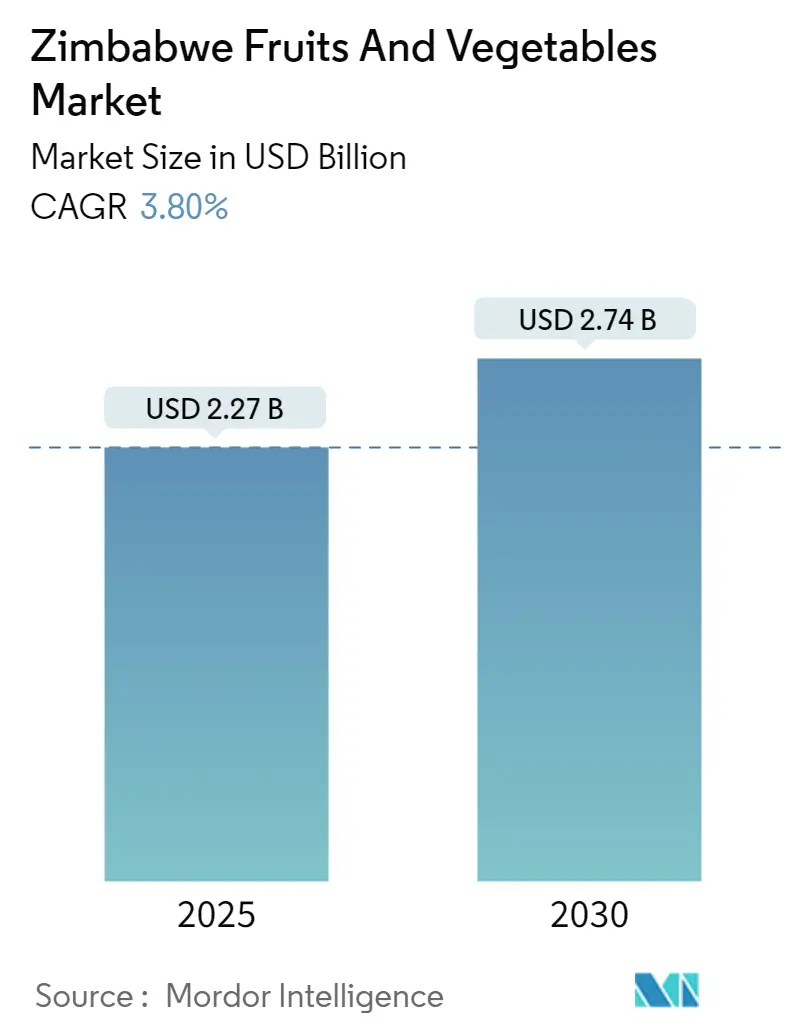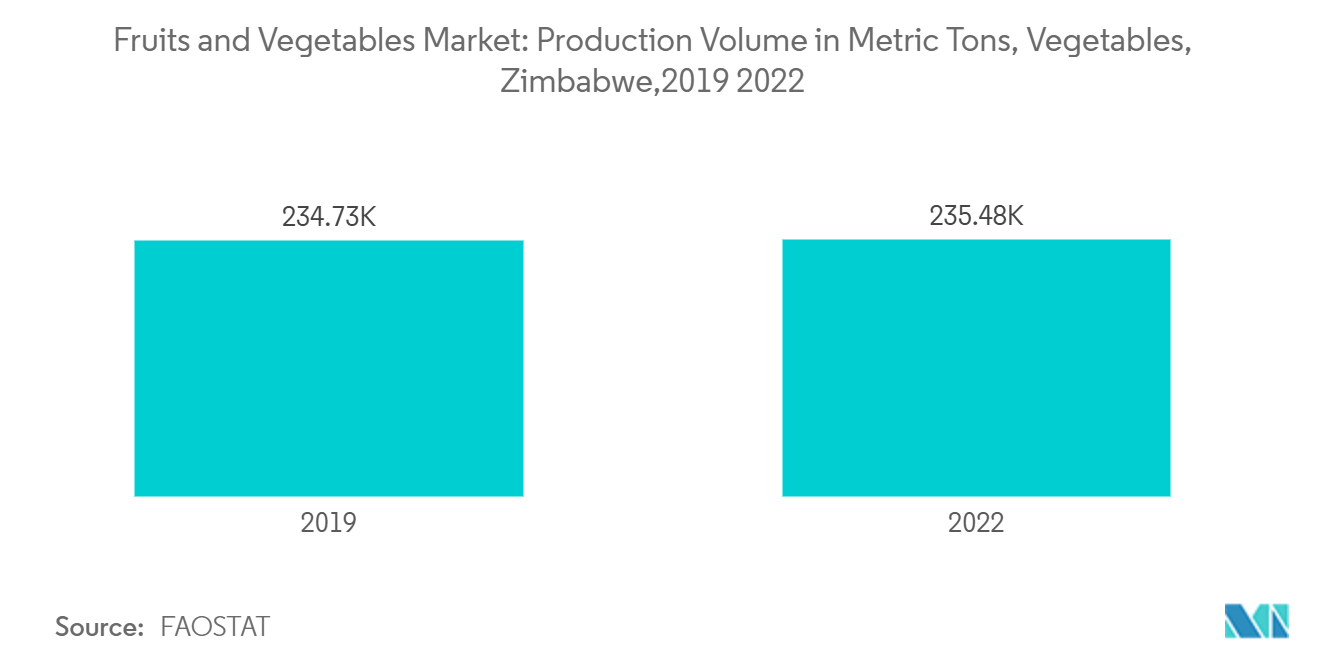
Zimbabwe Fruits and Vegetables Market Analysis
The Zimbabwe Fruits And Vegetables Market size is estimated at USD 2.27 billion in 2025, and is expected to reach USD 2.74 billion by 2030, at a CAGR of 3.8% during the forecast period (2025-2030).
- Zimbabwe achieved self-sufficiency in its fruit and vegetable supply. In 2022, vegetable production reached 190,004 metric tons, while fruit production stood at 15,030 metric tons, as per the Food and Agriculture Organization (FAO) data. Production of vegetables is predominantly localized, occurring in either commercial or communal settings. In 2022, approximately 27,517 hectares were dedicated to vegetable cultivation, while fruits were grown over 1,792 hectares.
- There's a rising demand in Zimbabwe for processed foods, including juices, ketchup, and edible oils. This surge in demand is bolstered by a rise in leafy vegetable production and growing awareness of the health benefits associated with regular vegetable consumption.
- Zimbabwe's crop export market is thriving with the government collaborations ensuring a seamless export process. A key player in this endeavor is Zimtrade, the National Trade Development and Promotion Organization of Zimbabwe. Zimtrade collaborates with both local and international partners, industry experts, and development cooperation entities. Their primary focus is to bolster Zimbabwe's export capabilities. They extend support to Zimbabwean exporters, including newcomers and those with potential, facilitating the global promotion and export of goods and services, with a particular emphasis on fruits and vegetables.
Zimbabwe Fruits and Vegetables Market Trends
Growing Opportunities in Fruit Exports
- As global demand for fresh fruits surges, heightened health awareness and evolving diets are propelling this trend. Zimbabwe, rich in wild fruits brimming with vital nutrients, stands to benefit significantly. According to the Horticultural Department Council (HDC) of Zimbabwe, the nation currently garners USD 120 million annually from its fruit sector, with ambitions to escalate this figure to USD 1 billion by 2030. Data from Michigan State University highlights that fruits and nuts rank among Zimbabwe's top ten export commodities. Key importers include South Africa, Mozambique, the United Kingdom, and Zambia. ITC Trade data reveals that in 2023, South Africa's imports of Zimbabwean fruits were valued at USD 15.2 million.
- Zimbabwe's export fruits encompass citrus varieties (oranges, grapefruit, lemons), subtropical selections (bananas, mangoes, passionfruit), deciduous types (peaches, apricots, plums, nectarines), apples, pears, and strawberries. Notably, citrus fruits dominate the export landscape, witnessing a consistent rise over the past eight years. The pinnacle was reached in 2022, with a record export value of USD 33.78 million, as reported by the Competition Tariff Commission (CTC). Fresh and dried oranges lead the export lineup.

Increasing Vegetable Production Driving the Market
- In Zimbabwe, vegetable production takes precedence over fruit cultivation. In 2022, vegetables made up 10% of the nation's total crop production, according to the Food and Agriculture Organization (FAO). Matabeleland South, contributing 15% to the nation's crop output, is set to become Zimbabwe's leading vegetable-producing region.
- During winter, smallholders ramp up their cultivation of vegetables and legumes. Interestingly, while most smallholders purchase seeds, only 8% rely on their own reserves. Zimbabwe's agricultural landscape is rich and varied, with a spectrum of vegetables being cultivated, including tomatoes, okra, cabbage, and carrots, across both the dry and rainy seasons. In 2022, tomatoes stood out with a production volume of 26,387 metric tons, as per the data by FAO Statistics.
- Modern agricultural practices have taken root in Zimbabwe, with greenhouses and precision irrigation systems being employed, all in line with Climate-Smart Agriculture (CSA) principles. Horticultural businesses, spanning production, processing, and marketing, have strategically set up near urban centers like Harare and Mutare, as well as along key transportation routes. Notably, Zimbabwe's vegetable exports have found a receptive destinations in the Netherlands, the United Kingdom, France, and Ireland.

Zimbabwe Fruits and Vegetables Market News
- September 2023: The government of Zimbabwe has initiated the Horticulture Enterprise Enhancement Project (HEEP) with funding of USD 15 million from the OPEC Fund, focusing on increasing incomes, food security, and empowerment for smallholder farmers engaged in profitable and sustainable horticulture value chains.
- January 2023: The Government has developed an agriculture and food systems transformation agenda, with a 2030 deadline to promote agriculture so that it contributes 18% of the GDP. As a part of this, they targeted to increase the availability of tomatoes by establishing processing plants and developing banana packing stations to minimize storage and transportation losses.
- October 2022: The Ministry of Lands, Agriculture, Fisheries, Water, and Rural Development introduced its plan to prioritize areas that stimulate export and aims to increase the export of vegetables by USD 285 million and increase the area under vegetables.
Zimbabwe Fruits and Vegetables Industry Segmentation
The report defines fruit and vegetable products in terms of end users. For the purpose of this report, the market scope includes only fresh fruits and vegetables. The scope does not include fruit and vegetable products processed in any other form, such as frozen, freeze-dried, cooked, canned, etc. The Zimbabwe fruits and vegetables market is segmented by fruits and vegetables. The report also includes the production analysis (volume), consumption analysis (value and volume), import analysis (value and volume), export analysis (value and volume), and price trend analysis. The report offers market estimation and forecast in value (USD) and volume (metric tons).
| Crop Type (Production Analysis, Consumption Analysis by Value and Volume, Import Market Analysis by Value and Volume, Export Market Analysis by Value and Volume, and Price Trend Analysis) | Fruits |
| Vegetables |
Zimbabwe Fruits And Vegetables Market Research Faqs
How big is the Zimbabwe Fruits And Vegetables Market?
The Zimbabwe Fruits And Vegetables Market size is expected to reach USD 2.27 billion in 2025 and grow at a CAGR of 3.80% to reach USD 2.74 billion by 2030.
What is the current Zimbabwe Fruits And Vegetables Market size?
In 2025, the Zimbabwe Fruits And Vegetables Market size is expected to reach USD 2.27 billion.
What years does this Zimbabwe Fruits And Vegetables Market cover, and what was the market size in 2024?
In 2024, the Zimbabwe Fruits And Vegetables Market size was estimated at USD 2.18 billion. The report covers the Zimbabwe Fruits And Vegetables Market historical market size for years: 2019, 2020, 2021, 2022, 2023 and 2024. The report also forecasts the Zimbabwe Fruits And Vegetables Market size for years: 2025, 2026, 2027, 2028, 2029 and 2030.
Our Best Selling Reports
Zimbabwe Fruits And Vegetables Industry Report
Statistics for the 2025 Zimbabwe Fruits And Vegetables market share, size and revenue growth rate, created by Mordor Intelligence™ Industry Reports. Zimbabwe Fruits And Vegetables analysis includes a market forecast outlook for 2025 to 2030 and historical overview. Get a sample of this industry analysis as a free report PDF download.


